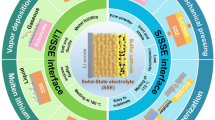Abstract
Solid state batteries are an emerging alternative to traditional liquid electrolyte cells that provide potential for safe and high-energy density power sources. This report describes a self-forming, solid state battery based on the Li/I2 couple using an LiI-rich LiI(3-hydroxypropionitrile)2 electrolyte (LiI–LiI(HPN)2). As the negative and positive active materials are generated in situ, the solid electrolyte–current collector interfaces play a critical role in determining the electrochemical response of the battery. Herein, we report the investigation of solid electrolyte–current collector interfaces with a self-forming LiI–LiI(HPN)2 solid electrolyte and the role of varying interface design in reducing resistance during cycling.




Similar content being viewed by others
References
Z. Zhang, Y. Shao, B. Lotsch, Y.-S. Hu, H. Li, J. Janek, L. F. Nazar, C.-W. Nan, J. Maier, M. Armand, and L. Chen: New horizons for inorganic solid state ion conductors. Energy Environ. Sci. 11, 1945 (2018).
H. Xu, Y. Li, A. Zhou, N. Wu, S. Xin, Z. Li, and J.B. Goodenough: Li3N-modified garnet electrolyte for all-solid-state lithium metal batteries operated at 40 °C. Nano Lett. 18, 7414 (2018).
W. Luo, Y. Gong, Y. Zhu, Y. Li, Y. Yao, Y. Zhang, K.K. Fu, G. Pastel, C.F. Lin, Y. Mo, E.D. Wachsman, and L. Hu: Reducing interfacial resistance between garnet-structured solid-state electrolyte and Li-Metal anode by a Germanium layer. Adv. Mater. 29, 1606042 (2017).
G.V. Alexander, N.C. Rosero-Navarro, A. Miura, K. Tadanaga, and R. Murugan: Electrochemical performance of a garnet solid electrolyte based lithium metal battery with interface modification. J. Mater. Chem. A 6, 21018 (2018).
X. Han, Y. Gong, K.K. Fu, X. He, G.T. Hitz, J. Dai, A. Pearse, B. Liu, H. Wang, G. Rubloff, Y. Mo, V. Thangadurai, E.D. Wachsman, and L. Hu: Negating interfacial impedance in garnet-based solid-state Li metal batteries. Nat. Mater. 16, 572 (2017).
L. Weinstein, W. Yourey, J. Gural, and G.G. Amatucci: Electrochemical impedance spectroscopy of electrochemically self-assembled lithium–iodine batteries. J. Electrochem. Soc. 155, A590 (2008).
W. Yourey, L. Weinstein, A. Halajko, and G.G. Amatucci: Pathways to enabling solid state electrolytically formed batteries: the solid electrolyte interphase. Electrochim. Acta 66, 193 (2012).
W. Yourey, L. Weinstein, A. Halajko, and G.G. Amatucci: Electrode development in a novel self-assembled lithium iodide battery. ECS Trans. 28, 159 (2010).
A. Abraham, J. Huang, P.F. Smith, A.C. Marschilok, K.J. Takeuchi, and E. S. Takeuchi: Communication—demonstration and electrochemistry of a self-forming solid state rechargeable LiI(HPN)2 based Li/I2 battery. J. Electrochem. Soc. 165, A2115 (2018).
H.X. Wang, Z.X. Wang, H. Li, Q.B. Meng, and L.Q. Chen: Ion transport in small-molecule electrolytes based on LiI/3-hydroxypropionitrile with high salt contents. Electrochim. Acta 52, 2039 (2007).
H. Wang, H. Li, B. Xue, Z. Wang, Q. Meng, and L. Chen: Solid-state composite electrolyte LiI/3-Hydroxypropionitrile/SiO2 for dye-sensitized solar cells. J. Am. Chem. Soc. 127, 6394 (2005).
F.-C. Liu, Z. Shadike, F. Ding, L. Sang, and Z.-W. Fu: Preferential orientation of I2–LiI(HPN)2 film for a flexible all-solid-state rechargeable lithium–iodine paper battery. J. Power Sources 274, 280 (2015).
F.-C. Liu, W.-M. Liu, M.-H. Zhan, Z.-W. Fu, and H. Li: An all solid-state rechargeable lithium-iodine thin film battery using LiI(3-hydroxypropionitrile)2 as an I− ion electrolyte. Energy Environ. Sci. 4, 1261 (2011).
Acknowledgments
This work was supported by the U.S. Department of Energy Office of Energy Efficiency and Renewable Energy under the Advanced Battery Materials Research program, award DE-EE0007785. Alyson Abraham and Mikaela Dunkin acknowledge support from the Graduate Assistance in Areas of National Need Fellowship. Bingjie Zhang thanks David Bock for helpful suggestions regarding SEM sample preparation. Esther Takeuchi acknowledges the generous support of William and Jane Knapp as the Jane Knapp Chair of Energy and the Environment.
Author information
Authors and Affiliations
Corresponding author
Supplementary Information
Supplementary material
Supplementary material
The supplementary material for this article can be found at https://doi.org/10.1557/mrc.2019.42
Rights and permissions
About this article
Cite this article
Abraham, A., Dunkin, M.R., Huang, J. et al. Interface effects on self-forming rechargeable Li/I2-based solid state batteries. MRS Communications 9, 657–662 (2019). https://doi.org/10.1557/mrc.2019.42
Received:
Accepted:
Published:
Issue Date:
DOI: https://doi.org/10.1557/mrc.2019.42




